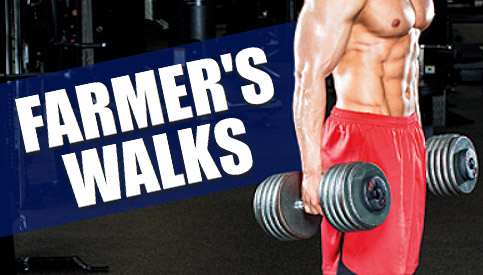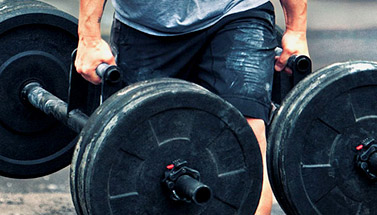THE “FARMER’S WALK” FOR BIGGER FOREARMS AND TRAPS

Pick up a pair of heavy objects… hold them at your sides… and start walking.
That’s pretty much all there is to this exercise, but the farmer’s walk is no joke when it comes to building up your grip strength, forearm size, upper back muscle, and core stability.
In fact, virtually every major muscle group in your body will be involved to some degree, making this a multi-purpose, highly functional exercise for improving your overall total body size and strength.
On top of its muscle stimulating effects, the farmer’s walk also provides an added cardiovascular component due to the high intensity nature of the exercise, especially during longer distance sets.
This movement works best as a workout finisher at the end of your training sessions, and here’s how to go about performing it properly…
How To Do The Farmer’s Walk
Proper Farmer’s Walk Form
You can ultimately use any set of heavy objects held at your sides (such as kettlebells, sandbags, farmer’s walk handles etc.) but for most average trainees a pair of dumbbells will be the obvious choice here.
The execution is pretty straightforward, but there are a few smaller form tips to keep in mind in order to maximize the effectiveness of the exercise and minimize the risk of injury…
1) Stand in between the dumbbells and squat down so that you’re lifting them off the ground in a deadlifting motion. You should be using weights that are fairly heavy for you, so it’s important that you don’t simply yank them off the ground using your lower back.
2) Make sure you’re gripping the dumbbells right in the middle of the handles since being even slightly off-center will end up affecting the entire set by throwing you out of balance.
3) Stand nice and tall with your head up, and be looking straight ahead at all times with your shoulders pulled back and your chest up.
4) Keep your core and glutes tight, and then begin walking in a straight line using small quick steps. Make sure to stay upright throughout the whole set and don’t allow your torso to lean or your shoulders to roll forward.
5) If you don’t have a lot of space and there’s a turn in your path, make sure to take the turn cautiously as any sudden awkward movements can be risky when carrying heavy dumbbells like this.
6) Continue walking either until your grip fully gives out and you have to set the dumbbells down or until you’ve covered the set distance you were aiming for. If you are going to complete forearm failure and have to lower the dumbbells to the floor, do so under control rather than just aimlessly dropping them.
How Far Should You Walk?
Just as you can perform low, medium and high rep sets on your other exercises in the gym, you can also go with heavier farmer’s walks over a shorter distance, lighter walks over a longer distance, or moderate walks somewhere in the middle.
These are the approximate distances I’d recommend for each…
Heavy Sets: 10-15 meters (approx. 30-50 feet)
Moderate Sets: 20-30 meters (approx. 65-95 feet)
Lighter Sets: 40-60 meters (approx. 130- 190 feet)
You can also mix it up by incorporating a variety of different loads/distances into your workouts.
When Should You Do Your Farmer’s Walks?
You can ultimately include the farmer’s walk in any workout of your choice, but since there is a good degree of upper back involvement I’d recommend including them alongside your back exercises if possible.
Regardless of which workout you include them in though, you’ll ideally want to perform them at the very end of the session since you don’t want to pre-fatigue your grip prior to training your other large muscle groups.
2-3 total sets is a good guideline, and just as you aim for progressive overload on all of your other exercises, make sure to treat your farmer’s walks in the same way by gradually increasing the distance travelled with a specific weight and/or by increasing the actual weight over time.
“Do I Really Need To Walk Or Can I Just Stand Still?”
If your only goal here is to build up your grip strength and forearm size, then performing a “static hold” by standing stationary with the weights at your sides will be fine.
However, if you want the added benefit of improving your core strength, increasing upper back activation, involving the glutes/quads/hamstrings, and adding in a cardiovascular element as well, a traditional farmer’s walk is what I’d recommend.

All in all, the farmer’s walk is a very simple but highly effective exercise for building total body muscle, strength, and functionality.
Not only is it a great muscle size and strength builder, but it also has direct carryover to several other basic compound exercises such as the lockout portion of a deadlift or in helping you remain upright during a squat.
It may look easy on the surface, but add in a couple sets of farmer’s walks to the end of your next workout using heavy weights and high intensity and you’ll quickly see just how physically and mentally challenging they can be.
If you found this article helpful, make sure to sign up for your FREE custom fitness plan below...




